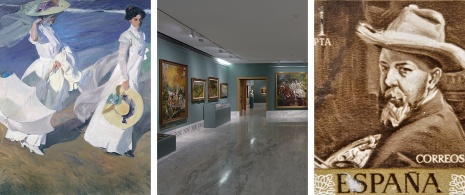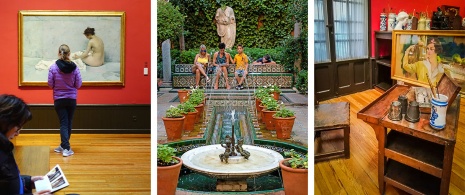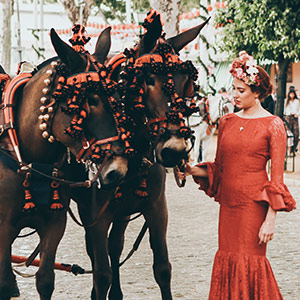
A journey through Sorolla's Spain
Light as a work of art
"The painter of light". This is how Joaquín Sorolla, one of the main figures in the history of Spanish art and one of the most internationally famous painters of his time, is known. Because this artist was able to capture light and movement in his paintings like none other. You'll find rural landscapes, typical Mediterranean seascapes, works of social realism, portraits,and more, all of which have one thing in common: a palpable warmth and sensitivity.What landscapes inspired this genius? Where can you find his main artworks? Take a pictorial journey along beaches lapped by crystal clear waters, through gardens and a world of colour.
-

Valencia, the city where the artist was born
The best way to understand Sorolla is to take a trip to Valencia, where in 1863 this unique painter was born into a family of modest means, and where he trained, at the Fine Arts School. In fact, on a tour of the city you can stop off at his birthplace, the church of Santa Catalina (where he was baptised), his first home (Calle Barcelona, 6), the church of San Martín (where he got married) and the Plaza del Mercado, which was to be the setting for his painting The Cry of the Palleter.But it's not until you take a stroll along the beaches in the area (and those of other towns in the Valencia Region, such as Jávea) that you’ll truly understand the shimmering reflections and the play of whites and blues captured by the painter in his scenes of women on the beach, children at play, or fishermen. To the north of the marina there’s a beach that stretches for 2,300 metres whose name changes as you walk along it: Arenas, Cabanyal and Malvarrosa. The scenes that Sorolla painted on this coast such as Walk on the Beach, and are all very well-known.How about visiting the museums where you'll find some of the artist's paintings? Why not visit the Valencia Museum of Fine Arts or the Benlliure House-Museum. The Valencia Institute of Modern Art (IVAM) and the Bancaja Cultural Centre have also held important exhibitions of the artist’s work. Close by, at the Castellón Museum of Fine Arts, you'll also find a selection of his works. As for monuments, go to the chapel at the old college of San Pablo (Lluis Vives Institute), which the Valencian painter immortalised in "El patio del instituto" or in Valencia's cemetery, where you'll find Sorolla's grave next to those of other important figures such as writer Blasco Ibáñez.
-

The family home in Madrid
If the warm Mediterranean sun was one of the factors that had the greatest impact on Sorolla's work, another was his visit to the Prado Museum (one of the most important museums in the world) when he was just 18 years old. There he discovered Velázquez's paintings, which defined his way of seeing art. Sorolla currently has a place of honour in the museum, next to his master - there are several of Sorolla's paintings hanging in the Prado Museum, like "Boys on the Beach". But if there’s one place in Madrid where you can discover the artist's true essence, it has to be the Sorolla Museum. You can't miss this old family residence that was turned into a museum following the wishes of his widow. On entering you'll leave the hustle and bustle of the city behind; you'll imagine the staircase that models used when posing for the artist; you'll hear the trickling of the fountains in the garden… and above all, you'll see some of Sorolla's best-known works: The Gardens at the Sorolla Family House,,, Walk by the Sea, , , ,,, and more.You could also visit the Real Academia de Bellas Artes de San Fernando (which holds some of his works), or Cercedilla in the Madrid Region, where Sorolla died in 1923.
-
All over Spain
As well as in these two important places in Sorolla's life, his works can be found in many other towns in Spain. The painter started studying gardens in Andalusia. In this area of the south of Spain you can visit the Malaga Museum, the Carmen Thyssen Museum in Malaga and the Museum of Fine Arts in Córdoba where you’ll also find some of his paintings. And don't forget Seville (which he depicted in "Palace of Pond, Royal Gardens in Seville", for example), or Granada, a city that impressed him after seeing the Sierra Nevada Mountains and the Alhambra.In the north of Spain, you can visit the A Coruña Museum of Fine Arts and the Vitoria-Gasteiz Museum of Fine Arts. In fact, Sorolla was very interested in the rough Cantabrian Sea. We see this in "On the Breakwater, San Sebastián", and "Under the Awning, Zarauz".Where else can we find Sorolla's paintings? The Murcia Museum of Fine Arts, the El Greco Museum in Toledo and the Municipal Museum of Fine Arts in Tenerife are a few examples.There is no denying that Sorolla knew Spain very well. In 1911 New York's Hispanic Society asked him to carry out a mural painting with Spain's provinces. Today it is known as "Vision of Spain". For this, the painter travelled around the country for almost eight years to get to know the costumes and customs of each area.
But however much you read about this great 19th century artist, the only way to appreciate the huge emotional power of his paintings is to come and see them for yourself. Discover Spain, Discover Sorolla's work and enjoy the colours of the Mediterranean. Let the light surround you. Because almost a century after his death, Sorolla has become a true classic. Because, as Huntington (the North American Hispanist who commissioned the panels for the Hispanic Society) said: "he has taken his painting theory to the limit and will live on because of that".







